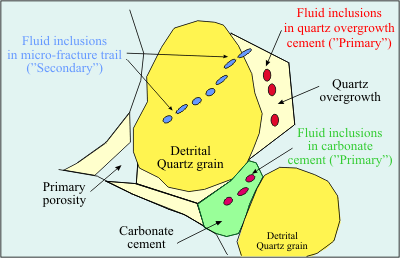 |
 |
 |
 |
 |
 |
||
 |
|||||||
Fluid Inclusion Analysis
(Extracted from Short Course Notes on Fluid Inclusion Microthermometry
by Paul Carey & John Parnell Geofluids Research Group, University of Aberdeen)What are fluid inclusions?
It is generally accepted that it is impossible to grow perfect, flawless crystals and such crystals do not occur in the natural world. Imperfections occur during crystal growth that may trap fluids present at the time of crystal growth. Further precipitation of mineral or deformation events can generate post-initial formation imperfections (e.g. during deformation, fractures may form that subsequently re-heal, leaving trails of imperfections along the plane of failure; precipitation of overgrowths on detrital grains will contain their own suite of imperfections, distinct from those in the core mineral etc.). These imperfections and their fluid contents form the basis of fluid inclusion studies.
Fluid inclusions are fluid-filled vacuoles typically 5 to 20 microns in size although very large (mm scale) inclusions do occur. The most commonly studied inclusions are 2-7 microns.
Fluids trapped within minerals provide information on the Pressure, Volume and Temperature conditions of precipitation of the mineral. When trapped within diagenetic minerals, fluid inclusions provide a means of examining the fluids present in ancient diagenetic environments. The fluid contained in the inclusion is a sample of the mineralising fluid. It could be a palaeo-water or petroleum or gas. Measurements made on fluid inclusions are generally concerned with the pressure and temperatures prevalent when the inclusions formed and the compositions of the inclusions.
There are three main assumptions that are made in dealing with fluid inclusions:
- The composition of the trapped fluid has not changed since inclusion formation
- The density of the trapped fluid has not changed since inclusion formation
- The volume of the inclusion has not changed since inclusion formation
Application to Exploration Geology
The study of fluid inclusions is applied in many branches of exploration geology, mainly because of the wealth of information that may be obtained from the careful examination of palaeofluids that were trapped during crystal growth and during subsequent stress events. The development of higher magnification lenses and enhanced imaging techniques has allowed these studies to be applied widely in the study of diagenetic environments, that typically contain much smaller inclusions.
The main body of application of fluid inclusion techniques in diagenetic environments is in the study of hydrocarbon reservoir rocks. This is hardly surprising, since diagenetic events are responsible for the preservation or destruction of porosity and permeability. Information on the physico-chemical conditions prevalent during diagenetic events is commonly preserved in trapped fluids (aqueous and oil) within the diagenetic minerals, and thus the study of fluid inclusions is a study of phase relationships through temperature and pressure changes.What can we tell from diagenetic fluid inclusions?
- Temperature of mineral precipitation
- Composition and origin of mineralising fluids
- Later history of temperature, pressure and fluid composition
- Petroleum migration history
- Relative timing of porosity occlusion
- Deformation event conditions
The most commonly used minerals in fluid inclusion studies are (in descending order):
Quartz
Fluorite
Halite
Calcite
Dolomite
Feldspar
Sphalerite
BariteSampling and Reporting
Outcrop samples (fresh) and well core and cuttings samples can be used, with a preference for cores. Core samples should be 1cm+ across, and cuttings of sandstone can be as small as 2mm. Sample Packing and shipping information is available.
Twenty homogenisation temperatures are typically sought and 5 freezing temperatures to deduce the fluid salinity, although this is not always possible where cement is limited. Ultra violet light is used to search for oil inclusions. Populations of inclusions are distinguished and put in a time sequence and integrated into a diagenetic sequence where possible. Where oil is present it may be possible to provide a general indication as to the °API gravity.
